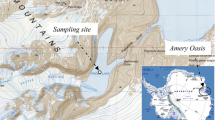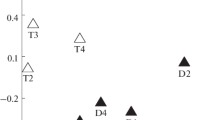Abstract
Phylogenetic and statistical analyses of 16S rRNA gene libraries were used for the investigation of actinobacterial communities present in two tropical estuarine sediments (Santos-São Vicente estuary, Brazil). The libraries were constructed from samples collected at the brackish end of the estuary, highly hydrocarbon-contaminated, and at the marine end, uncontaminated. Clones from the marine end of the estuary were all related to sequences from non-cultured Actinobacteria and unidentified bacteria recovered from a wide range of environmental samples, whereas clones from the brackish end were mainly related to sequences from cultured Actinobacteria. Statistical analyses showed that the community recovered from the hydrocarbon-contaminated sediment sample, at the brackish end, was less diverse than the uncontaminated one, at the marine end, and that the communities from the two libraries were differently structured, suggesting that these may have not originated from the same community. The recognition of the spatial pattern of actinobacterial distribution in a natural environment is a first step towards understanding the way these communities are organized, providing valuable data for further investigations of their taxonomic and functional diversity.
Similar content being viewed by others
References
Amann R.I., Ludwig W. and Schleifer K. 1995. Phylogenetic identification and in situ detection of individual microbial cells without cultivation. Microbiol. Rev. 59: 143–169.
Anon. 1991. Determinations of petroleum hydrocarbons in sediments. Reference methods for marine pollution studies no 20. UNEP (United Nations Environment Programme).
Anon. 1999. Canadian Sediment Quality Guidelines for the protection of Aquatic Life. Summary Tables., Environment Canada.
Anon. 2001. Sistema Estuarino Santos-São Vicente. Relatório Técnico. CETESB, São Paulo.
Anon. 1985. NRC (National Research Council). Oil in the sea, inputs, fates and effects. National Academy Press, Washington D.C., USA.
Atlas R.M., Horowitz A., Krichevsky M. and Bej A.K. 1991. Response of microbial populations to environmental disturbance. Microb. Ecol. 22: 249–256.
Bell K.S., Philp J.C., Aw D.W. and Christofi N. 1998. The genus Rhodococcus. J. Appl. Microbiol. 85(2): 195–210.
Benson D.A. et al. 2002. GenBank. Nucleic Acids Res. 30: 17–20.
Bond P.L., Hugenholtz P., Keller J. and Blackall L.L. 1995. Bacterial community structures of phosphate-removing and non-phosphate-removing activated sludges from sequencing batch reactors. Appl. Environ. Microbiol. 61: 1910–1916.
Bonnet R., Suau A., Dore J., Gibson G.R. and Collins M.D., 2002. Differences in rDNA libraries of faecal bacteria derived from 10- and 25-cycle PCRs. Int. J. Syst. Evol. Microbiol. 52(Pt3): 757–763.
Bowman J.P. and McCuaig R.D. 2003. Biodiversity, community structural shifts, and biogeography of prokaryotes within antarctic continental shelf sediments. Appl. Environ. Microbiol. 69: 2463–2483.
Cheung P.Y. and Kinkle B.K., 2001. Mycobacterium diversity and pyrene mineralization in petroleum-contaminated soils. Appl. Environ. Microbiol. 67(5): 2222–2229.
Colquhoun J.A. et al. 1998. Taxonomy and biotransformation ac-tivities of some deep-sea actinomycetes. Extremophiles 2(3): 269–277.
Dojka M.A., Hugenholtz P., Haack S.K. and Pace N.R., 1998. Microbial diversity in a hydrocarbon- and chlorinated-solvent-contaminated aquifer undergoing intrinsic bioremediation. Appl. Environ. Microbiol. 64(10): 3869–3877.
Ewing B., Hillier L., Wendl M. and Green P. 1998. Basecalling of automated sequencer traces using phred. I. Accuracy assessment. Genome Res. 8: 175–185.
Farreley V., Rainey F.A. and Stackebrandt E., 1995. Effect of genome size and rrn gene copy number on PCR amplification of 16S rRNA genes from a mixture of bacterial species. Appl. Environ. Microbiol. 61: 2798–2801.
Farrington J. and Tripp R.W., 1975. Hydrocarbons in cores of northwestern Atlantic coastal and continental margin sediments. Estuar. Coast. Mar. Sci. 5: 793–808.
Felske A., Rheims H., Wolterink A., Stackebrandt E. and Akkermans A.D.L. 1997. Ribosome analysis reveals prominent activity of an uncultured member of the class Actinobacteria in grassland soils. Microbiology 143: 2983–2989.
Fulthorpe R.R., Rhodes A.N. and Tiedje J.M. 1998. High levels of endemicity of 3-chlorobenzoate-degrading soil bacteria. Appl. Environ. Microbiol. 64: 1620–1627.
Gray J.P. and Herwig R.P. 1996. Phylogenetic analysis of the bacterial communities in marine sediments. Appl. Environ. Microbiol. 62(11): 4049–4059.
Greene E.A., Kay J.G., Jaber K., Stehmeier L.G. and Voordouw G. 2000. Composition of soil microbial communities enriched on a mixture of aromatic hydrocarbons. Appl. Environ. Microbiol. 66(12): 5282–5289.
Grifoll M., Casellas M., Bayona J.M. and Solanas A.M. 1992. Isolation and characterization of a fluorene-degrading bacterium: identification of ring oxidation and ring fission products. Appl. Environ. Microbiol. 58(9): 2910–2917.
Head I.M., Saunders J.R. and Pickup R.W. 1998. Microbial Evolution, Diversity, and Ecology: A Decade of Ribosomal RNA Analysis of Uncultivated Microorganisms. Microb. Ecol. 35(1): 1–21.
Heuer H., Krsek M., Baker P., Smalla K. and Wellington E.M. 1997. Analysis of actinomycete communities by specific amplification of genes encoding 16S rRNA and gel-electrophoretic separation in denaturing gradients. Appl. Environ. Microbiol. 63(8): 3233–3241.
Hugenholtz P., Goebel B.M. and Pace N.R., 1998. Impact of culture-independent studies on the emerging phylogenetic view of bacterial diversity. J. Bacteriol. 180(18): 4765–4774.
Hughes J.B., Hellmann J.J., Ricketts T.H. and Bohannan B.J.M. 2001. Counting the uncountable: statistical approaches to estimating microbial diversity. Appl. Environ. Microbiol. 67: 4399–4406.
Ilori M.O.N. and Amund D.- I. 2000. Degradation of anthracene by bacteria isolated from oil polluted tropical soils. Z. Naturforsch. 55: 890–897.
Jensen P.R., Dwight R. and Fenical W. 1991. Distribution of actinomycetes in near-shore tropical marine sediments. Appl. Environ. Microbiol. 57(4): 1102–1108.
Kanaly R.A. and Harayama S. 2000. Biodegradation of high-molecular-weight polycyclic aromatic hydrocarbons by bacteria. J. Bacteriol. 182: 2059–2067.
Kästner M., Breuer-Jammali M. and Mahro B. 1994. Enumeration and characterization of the soil microflora from hydrocarbon-contaminated soil sites able to mineralize polycyclic aromatic hydrocarbons (PHA). Appl. Microbiol. Biotechnol. 41: 267–273.
Kelley I. and Cerniglia C.E., 1995. Degradation of a mixture of high-molecular-weight polycyclic aromatic hydrocarbons by a Mycobacterium strain PYR-1. J. Soil Contam. 74: 77–91.
Lane D. 1991. 16S/23S rRNA sequencing.. In: Stackebrandt E. and Goodfellow M. (eds), Nucleic Acid Techniques in Bacterial Systematics. West Sussex, England, 115–175.
Lang E. 1996. Diversity of Bacterial capabilities in utilizing alkylated benzenes and other aromatic compounds. Lett. Appl. Microbiol. 23: 257–260.
Levin S.A. 1992. The problem of pattern and scale in ecology. Ecology 73: 1943–1967.
Lindstrom J.E., Barry R.P. and Braddock J.F. 1999. Long-term effect on microbial communities after a subartic oil spill. Soil Biol. Biochem. 31: 1677–1689.
Maidak B.L. et al. 2001. The RDP-II (Ribosomal Database Project). Nucleic Acids Res 29(1): 173–174.
Manly B.F.J. 1997. Randomization. In Randomization, Bootstrap and Monte Carlo Methods in Biology. Chapman and Hall, Glasglow, UK, 1–23.
Martin A.P. 2002. Phylogenetic approaches for describing and comparing the diversity of microbial communities. Appl. Environ. Microbiol. 68: 3673–3682.
Mincer T.J., Jensen P.R., Kauffman C.A. and Fenical W. 2002. Widespread and persistent populations of a major new marine actinomycete taxon in ocean sediments. Appl. Environ. Microbiol. 68(10): 5005–5011.
Miskin I.P., Farrimond P. and Head I.M. 1999. Identification of novel bacterial lineages as active members of microbial populations in a freshwater sediment using a rapid RNA extraction procedure and RT-PCR. Microbiology 145 (Pt8): 1977–1987.
Moran M.A., Rutherford L.T. and Hodson R.E. 1995. Evidence for indigenous Streptomyces populations in a marine environment determined with a 16S rRNA probe. Appl. Environ. Microbiol. 61(10): 3695–3700.
Nogales B., Moore E.R., Abraham W.R. and Timmis K.N., 1999. Identification of the metabolically active members of a bacterial community in a polychlorinated biphenyl-polluted moorland soil. Environ. Microbiol. 1(3): 199–212.
Nogales B. et al. 2001. Combined use of 16S ribosomal DNA and 16S rRNA to study the bacterial community of polychlorinated biphenyl-polluted soil. Appl. Environ. Microbiol. 67(4): 1874–1884.
Pellizari V.H., Bezborodnikov S., Quensen J.F. 3rd and Tiedje J.M. 1996. Evaluation of strains isolated by growth on naphthalene and biphenyl for hybridization of genes to dioxygenase probes and polychlorinated biphenyl-degrading ability. Appl. Environ. Microbiol. 62(6): 2053–2058.
Polz M.F. and Cavanaugh C.M. 1998. Bias in template-to-product ratios in multitemplate PCR. Appl. Environ. Microbiol. 64(10): 3724–3730.
Rao C.R. 1980. Diversity and dissimilarity coefficients: a unified approach. Theor. Pop. Biol. 21: 24–43.
Rodrigues D.F. 2002. Caracterização polifásica da biodiversidade de isolados degradadores de poluentes xenobióticos na baixada santista. MSc Thesis Thesis, University of São Paulo (USP), São Paulo.
Schwarz K., Hansen-Hagge T. and Batram C. 1990. Improved yields of long PCR products using gene 32 protein. Nucleic Acids Res. 18: 1079.
Shi S. et al. 1999. Molecular analysis of microbial community structures in pristine and contaminated aquifers: field and laboratory microcosms experiments. Appl. Environ. Microbiol. 65: 2143–2150.
Singleton D.R., Furlong M.A., Rathbun S.L. and Whitman W.B. 2001. Quantitative comparisons of 16S rRNA gene sequence libraries form environmental samples. Appl. Environ. Microbiol. 67: 4374–4376.
Stach J.E.M. et al. 2003. Statistical approaches for estimating actinobacterial diversity in marine sediments. Appl. Environ. Microbiol. 69: 6189–6200.
Stackebrandt E. and Goebel B.M. 1994. Taxonomic note: a place for DNA:DNA reassociation and 16S rRNA sequence analysis in the present species definition in bacteriology. Int. J. System. Bacteriol. 44: 846–849.
Suzuki M.T. and Giovannoni S.J. 1996. Bias caused by template annealing in the amplification of mixtures of 16S rRNA genes by PCR. Appl. Environ. Microbiol. 62: 625–630.
Swofford D.L. 2000. PAUP*. Phylogenetic Analysis Using Parsimony (*and Other Methods). Sunderland, Massachusetts, USA.
Telles G.P. and Silva F.R, 2001. Trimming and clustering sugarcane ESTs. Gen. Mol. Biol. 24: 17–23.
Thompson J.D., Higgins D.J. and Gibson T.J. 1994. CLUSTAL W: improving the sensitivity of progressive multiple sequence alignment through sequence weighting, position specific gap penalties and weight matrix choice. Nucleic Acids Res. 22: 4673–4680.
Torsvik V., Goksoyr J. and Daae F.L. 1990. High diversity in DNA of soil bacteria. Appl. Environ. Microbiol. 56: 782–787.
Urakawa H., Kita-Tsukamoto K. and Ohwada K. 1999. Microbial diversity in marine sediments from Sagami Bay and Tokyo Bay, Japan, as determined by 16S rRNA gene analysis. Microbiology 145: 3305–3015.
van Elsas J.D. and Smalla K. 1995. Extraction of microbial community DNA from soils.. In: Akkerman A.D., van Elsas J.D. and Bruijn F.J. (eds), Molecular Microbial Ecology Manual. Kluwer Academic Publishers, Dordrecht, Netherlands, 1–11.
Volkman J.K., Holdsworth G.D., Neill G.P. and Bavor H.J.J. 1992. Identification of natural, anthropogene and petroleum hydrocarbons in aquatic sediments. Sci. Total Environ. 112: 203–219.
Wagner A. et al. 1994. Surveys of gene families using polymerase chain reaction: PCR selection and PCR drift. Syst. Biol. 43: 250–261.
Wagner-Dobler I. et al. 1998. Microcosm enrichment of biphenyl-degrading microbial communities from soils and sediments. Appl. Environ. Microbiol. 64(8): 3014–3022.
Watve M.G. and Gangal R.M. 1996. Problems in measuring bacterial diversity and a possible solution. Appl. Environ. Microbiol. 62: 4299–4301.
Wintzingerode F.V., Göbel U.B. and Stackebrandt E. 1997. Determination of microbial diversity in environmental samples: pitfalls of PCR-based rRNA analysis. FEMS Microbiol. Rev. 21: 213–229.
Wright S. 1978. Genetic variability in natural populations: methods. In Evolution and the genetics of populations. The University of Chicago Press, Chicago, USA,, 79–103.
Yumoto I. et al. 2002. Dietzia psychralcaliphila sp. nov., a novel, facultatively psychrophilic alkaliphile that grows on hydrocarbons. Int. J. Syst. Evol. Microbiol. 52(Pt 1): 85–90.
Author information
Authors and Affiliations
Corresponding author
Rights and permissions
About this article
Cite this article
Piza, F.F., Prado, P.I. & Manfio, G.P. Investigation of bacterial diversity in Brazilian tropical estuarine sediments reveals high actinobacterial diversity. Antonie Van Leeuwenhoek 86, 317–328 (2005). https://doi.org/10.1007/s10482-005-0162-0
Received:
Accepted:
Issue Date:
DOI: https://doi.org/10.1007/s10482-005-0162-0




